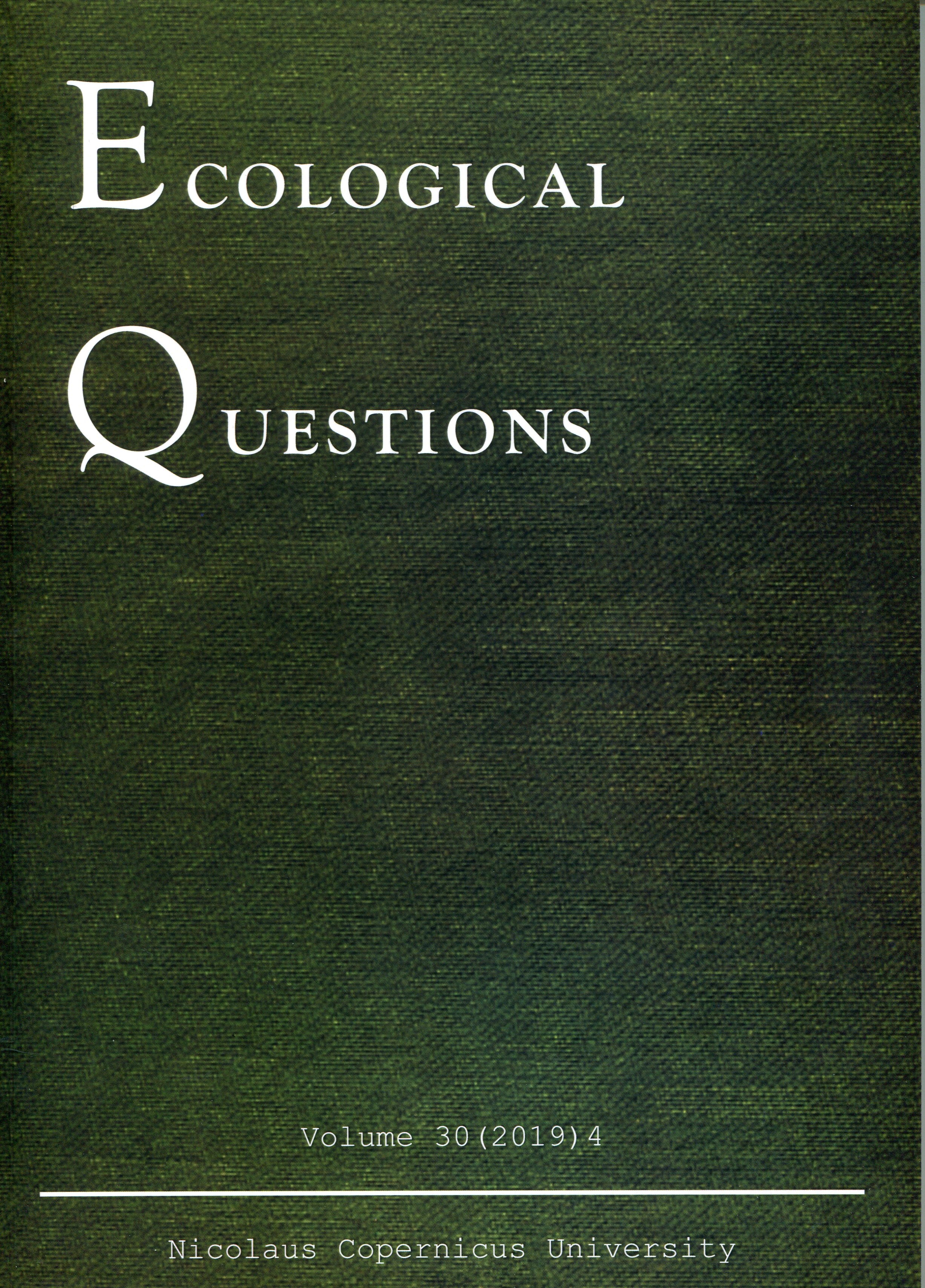Comparison of the carbon sequestration potential of young Tectona grandis L. f. (Teak) and Dendrocalamus strictus (Roxb.) Nees (Bamboo) plantations in the landscape of central India
DOI:
https://doi.org/10.12775/EQ.2019.028Keywords
biomass carbon, corporate social responsibility, deforestation, climate changeAbstract
The Kyoto Protocol addresses the issues related to global warming and it is the responsibility of the signatory countries to protect the sinks and reservoirs of greenhouse gases, to increase forest plantations and to promote sustainable forest management. India is also one of the signatories of the Kyoto Protocol, which is why various forest plantations have been established in the country. The present study compares the carbon sequestration potential of three-year-old Tectona grandis (teak) and Dendrocalamus strictus (bamboo) plantations in the state of Madhya Pradesh of India. It is concluded that D strictus sequesters more carbon than T. grandis and both species are suited for plantations in tropical areas of India.References
Barlow J.L., 2016, Anthropogenic disturbance in tropical forests can double biodiversity loss from deforestation. Nature 535(7610): 144-147.
Behera M D., Tripathi P., Das P., Srivastava S.K., Roy P.S., Joshi C., Behera P.R., Deka J., Kumar P., Khan M.L. & Tripathi, O.P., 2018, Remote sensing based deforestation analysis in Mahanadi and Brahmaputra river basin in India since 1985. Journal of Environmental Management 206: 1192-1203. (doi: 10.1016/j.jenvman.2017.10.015. Epub 2017 Nov 15).
Bruinsma J., 2017, World Agriculture: Towards 2015/2030: An FAO study. Routledge, London.
Global Forest Resources Assessment, 2015, How are the world’s forests changing? FAO, Rome. (http://www.fao.org/3/a-i4793e.pdf).
IPCC, 2003, Intergovernmental Panel on Climate Change, Good Practice Guidance for Land Use, Land-Use Change and Forestry, edited by J. Penman, M. Gytarsky, T. Hiraishi, T. Krug, D. Kruger, R. Pipatti, L. Buendia, K. Miwa, T. Ngara, K. Tanabe, F. Wagner. Institute for Global Environmental Strategies (IGES), Kamiyamaguchi, Japan. (http://www.ipcc-nggip.iges.or.jp).
Jana B.K., Biswas S., Majumder M., & Roy P.K., 2009, Carbon Sequestration Rate and Aboveground Biomass Carbon Potential of Four Young Species. Journal of Ecology and Natural Environment 1(2): 15-24.
Jha K.K., 2015, Carbon storage and sequestration rate assessment and allometric model development in young teak plantations of tropical moist deciduous forest, India. Journal of Forestry Research 26(3): 589-604.
Kaul M, Mohren G.M.J. & Dadhwal V.K., 2010, Carbon storage and sequestration potential of selected tree species in India. Mitigation and Adaptation Strategies for Global Change 15(5): 489-510.
Kaushal R., Subbulakshmi V., Tomar J.M.S., Alam N.M., Jayaprakash J, Mehta H. & Chaturvedi O.P., 2016, Predictive models for biomass and biomass carbon stock estimation in male bamboo (Dendrocalamus strictus L.) in Doon valley, India. Acta Ecologica Sinica 36(6): 469-476.
Kaushik S., Singh Y.P., Kumar D., Thapliyal M. & Barthwal S., 2015, Bamboos in India. ENVIS Centre on Forestry. National Forest Library and Information Centre. FRI, Dehradun,
India.
Kumar B.M. & Kunhamu T.K., 2011, Quarter Century of Agroforestry Research in Kerala: A Compendium of Research Publications. Kerala Agricultural University, Thrissur, Kerala, India.
Kumar K.S., 2015, Decentralisation and democratic forest reforms in India: Moving to a rights-based approach. Forest Policy and Economics 51: 1-8.
Landry J.S., 2016, Non-deforestation fire vs. fossil fuel combustion: the source of CO2 emissions affects the global carbon cycle and climate responses. Biogeosciences (BG) 13: 2137-2149.
Lobovikov M., Paudel S., Piazza M., Ren H. & Wu J., 2007, World Bamboo Resources: a thematic study prepared in the framework of the Global Forest Resources Assessment 2005. Food and Agriculture Organization of United Nations, Rome. (http://www.fao.org/3/a-a1243e.pdf).
Melkania N.P., 2009, Carbon sequestration potential in Indian natural and planted forests. Indian Forester 135: 380-392.
Menon S. & Bawa K.S., 1998, Deforestation in the tropics: reconciling disparities in estimates for India. Ambio 27(7): 576-577.
Pawson S., Brin A., Brockerhoff E., Lamb D., Payn T., Paquette A. & Parrotta J., 2013, Plantation forests, climate change and biodiversity. Biodiversity & Conservation 22(5): 1203-1227.
Raizada A., Parandiyal A.K. & Ghosh B.N., 2003, Estimation of carbon flux through litter fall in forest plantation of India. Indian Forester 129(7): 881–894.
Ravindranath N.H., 1994, Indian forest conservation and tropical deforestation. Ambio 23(8): 521-523.
Reddy S.C., Jha C.S., Dadhwal V.K. & Diwakar P.G., 2016, Quantification and monitoring of deforestation in India over eight decades. Biodiversity & Conservation 25(1): 93-116.
Salunkhe O. & Khare P.K., 2016, Aboveground biomass and carbon biomass stock of tropical deciduous forest ecosystems of Madhya Pradesh, India. International Journal of Ecology and Environmental Sciences 42(S): 75–81.
Singh N.A. & Singh J.S., 1999, Biomass, net primary production and impact of bamboo plantation on soil redevelopment in a dry tropical region. Forest Ecology and Management: 119(1-3): 195-207.
Singh P., Dubey P. & Jha K.K., 2006, Biomass production and carbon storage at harvest age in superior Dendrocalamus strictus Nees. Plantation in dry deciduous forest region of India. Indian Journal of Forestry 29(4): 353-360.
Updegraff K., Baughman M.J. & Taff S.J., 2004, Environmental benefits of cropland conversion to hybrids poplar: Economic and policy considerations. Biomass and Bioenergy 27: 411–428.
van der Werf G.R., Morton D.C., DeFries R.S., Olivier J.G.J., Kasibhatla P.S., Jackson R.B., Collatz G.J. & Randerson J.T., 2009, CO2 Emissions from Forest Loss. Nature Geoscience 2: 737-738.
Winjum J.K. & Schroeder P.E., 1997, Forest plantations of the world: their extent, ecological attributes and carbon storage. Agricultural and Forest Meteorology 84: 153-167.
Downloads
Published
How to Cite
Issue
Section
Stats
Number of views and downloads: 994
Number of citations: 0



